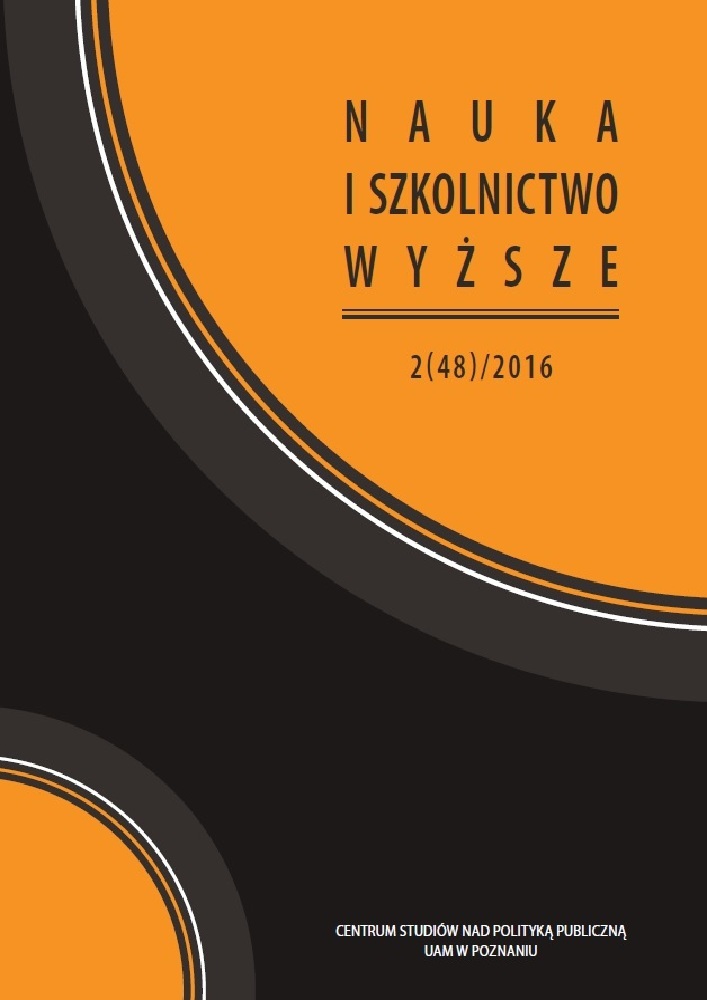Abstract
The paper presents the results of studies on the estate autonomy and accountability of publicly funded higher education institutions in Poland. An attempt has been made to answer the questions: “Was the level of HEI campus use in recent years the subject of public and administrative control? Were the decisions on significant extension of campuses economically viable?” The questions are of special importance in view of the deepening demographic decline, the lower level of public funding and the growing estate operating costs. An analysis of empirical data shows that when considerable resources, both national and European, were available for HEI infrastructure upgrading and development, Polish HEIs were not under an obligation to show how they manage the assets at their disposal. This may have contributed to a substantial, albeit not always judicious increase in the space available, which in turn may give rise to financial problems of individual HEIs and affect the future of the whole system of higher education.
References
Akademiska Hus (2015). Financial information. http://akademiskahus.se/en/about-us/financial-information [20.10.2016].
AMA (2010). Guidance on the Effective Management of Space for Scotland’s colleges. https://www.webarchive.org.uk/wayback/archive/20110411223721/ http://www.sfc.ac.uk/web/FILES/ReportsandPublications/Guidance_on_the_Effective_Management_of_Space_for_Scotland%c3%a2%e2%82%ac%e2%84%a2s_colleges.pdf [20.10.2016].
Antonowicz, D., Gorlewski, B. (2011). Demograficzne tsunami. Raport Instytutu Sokratesa na temat wpływu zmian demograficznych na szkolnictwo wyższe do 2020 roku. Warszawa: Instytut Sokratesa.
APPA (2015). The APPA Facilities Performance Indicators Report. http://appa.org/research/fpi [20.10.2016].
Bladh, A. (2007). Institutional Autonomy with Increasing Dependency on Outside Actors. Higher Education Policy. 20(3): 243-259.
Bloom, D.E., Hartley, M., Rosovsky, H. (2007). Beyond Private Gain: The Public Benefits of Higher Education. W: J.J.F. Forest, P.G. Altbach (red.). International Handbook of Higher Education (293-308). Dordrecht: Springer.
Clark, B.R. (1998). Creating Entrepreneurial Universities: Organizational Pathways of Transformation. Oxford: Pergamon Press – Elsevier.
Deem, R., Hillyard, S., Reed, M. (2007). Knowledge, Higher Education, and the New Managerialism. The Changing Management of UK Universities. Oxford: Oxford University Press.
Estermann, T., Nokkala, T. (2009). University Autonomy in Europe I. Exploratory study. Brussels: European University Association.
Estermann, T., Nokkala, T., Steinel, M. (2011). University Autonomy in Europe II. The Scorecard. Brussels: European University Association.
Goedegebuure, L., Kaiser, F., Maassen, P., Meek, L., Vught, F. van, Weert, E. de (1993). International Perspectives on Trends and Issues in Higher Education Policy. W: L. Goedegebuure, F. Kaiser, P. Maassen, L. Meek, F. van Vught, E. de Weert (red.). Higher Education Policy. An International Comparative Perspective (315-348). Oxford: Pergamon Press.
GUS (2015). Szkoły wyższe i ich finanse. http://stat.gov.pl/obszary-tematyczne/edukacja/edukacja/szkoly-wyzsze-i-ichfinanse-w-2014-r-,2,11.html [20.10.2016].
Hancock, S., Hughes, G., Walsh, E. (2012). Universities and the Informal Knowledge Economy. W: P. Temple (red.). Universities in Knowledge Economy. Higher Education Organisation and Global Change (118-135). London – New York: Routledge.
Harris, J.M., Roach, B. (2013). Environmental and Natural Resource Economics. A contemporary Approach. New York: Routledge.
HEFCE (2010). Performance in higher education estates. http://www.hefce.ac.uk/media/hefce1/pubs/hefce/2011/1117/11_17.pdf [20.10.2016].
HESA (2016). Estates management record. Coverage of the record. http://hesa.ac.uk [20.10.2016].
Joroff, M., Louargand, M., Lambert, S., Becker, F. (1993). Strategic Management of the Fifth Resource: Corporate Real Estate. Norcross: Industrial Development Research Foundation.
Kaipeng, G., Juan, L. (2011). Higher Education: Public Good or Private Good? W: L. Zhang, C. Zhang, (red.). Engineering Education and Management (581-585). Berlin: Springer.
Kwiek, M. (2010). Finansowanie szkolnictwa wyższego w Polsce a transformacje finansowania publicznego szkolnictwa wyższego w Europie. CPP RPS. 16: 1-54.
Kwiek, M. (2015). Uniwersytet w dobie przemian. Instytucje i kadra akademicka w warunkach rosnącej konkurencji. Warszawa: Wyd. Naukowe PWN.
Levin, H.M. (1987). Education as a Public and a Private Good. Journal of Policy and Management. 6(4): 628-641.
Marginson, S. (2011). Imagining the global. W: R. King, S. Marginson, R. Naidoo (red.). Handbook on Globalization and Higher Education (10-39). Cheltenham: Edward Elgar Publishing.
Neave, G. (2012). The Evaluative State, Institutional Autonomy and Reengineering Higher Education in Western Europe. Hampshire: Palgrave Macmillan.
Pinheiro, R., Benneworth, P., Jones, G.A. (2012). Understanding Regions and the Institutionalization of Universities, W: R. Pinheiro, P. Benneworth, G.A. Jones (red.). Universities and Regional Development. A Critical Assessment of Tensions and Contradictions (11-32). London: Routledge.
Ranking Web of Universities (2016). Countries arranged by Number of Universities in Top Ranks. www.webometrics.info [20.10.2016].
Rogers, P.P., Jalal, K.F., Boyd, A. (2008). An Introduction to Sustainable Development. London: Earthscan.
Rybkowski, R. (2015). Autonomia a rozliczalność – polskie wyzwania. Nauka i Szkolnictwo Wyższe. 1(45): 95-115.
Rymarzak, M. (2014). University space management exemplified by selected European entities. Real Estate Management and Valuation. 22(2): 22-29.
Salmi, J. (2007). Autonomy from the State vs Responsiveness to Markets. Higher Education Policy. 20: 223-242.
Samuelson, P.A. (1954). The Pure Theory of Public Expenditure. Review of Economics and Statistics. 36(4): 387-389.
SCUP (2015). SCUP’s Campus Facilities Inventory. http://scup.org/page/resources/cfi [20.10.2016].
SMG (2006). Managing space: A review of English further education and HE overseas. http://www.smg.ac.uk/documents/FEandoverseas.pdf [20.10.2016].
Szadkowski, K. (2015). Uniwersytet jako dobro wspólne. Podstawy krytycznych badań nad szkolnictwem wyższym. Warszawa: Wyd. Naukowe PWN.
TEFMA (2009). Space Planning Guidelines, Edition 3. http://www.tefma.com/uploads/content/26TEFMA-SPACE-PLANNING-GUIDELINES-FINAL-ED3-28-AUGUST-09. pdf [20.10.2016].
Thorens, J. (1998). Academic freedom and university autonomy. Prospects. 28(3): 401-407.
Trow, M. (2007). Reflections on the Transition from Elite to Mass to Universal Access: Forms and Phases of Higher Education in Modern Societies since WWII. W: J.J.F. Forest, P.G. Altbach (red.), International Handbook of Higher Education. Dordrecht: Springer.
UNESCO (2016). Teachers in tertiary education programmes. www.data.uis.unesco.org [20.10.2016].
Verhoest, K., Peters, B.G., Bouckaert, G., Verschuere, B. (2004). The Study of Organisational Autonomy: A Conceptual Review. Public Administration and Development. 24(2): 101-118.
Wheelahan, L. (2012). Accessing knowledge in the university of the future. W: R. Barnett (red.). The Future University. Ideas and Possibilities (39-49). London – New York: Routledge.
Wojewnik-Filipkowska, A., Rymarzak, M., Lausberg, C. (2015), Current managerial topics in public real estate asset management. Świat Nieruchomości. 94: 5-10.
